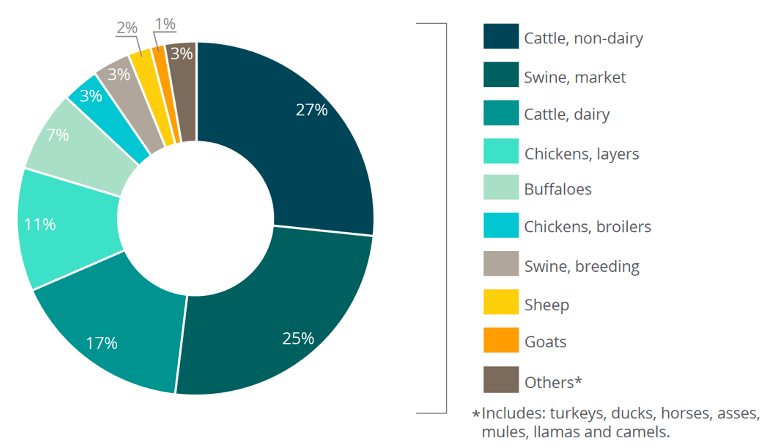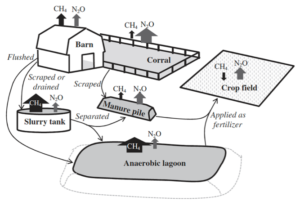Jump to: Factors affecting manure management | Mitigation strategy and options | Case Study
What is manure management?
Manure management is the process in which animal excretion is captured, stored, treated, and used. Manure is a cost-efficient and valuable fertilizer containing varying amounts of nutrients, such as nitrogen and phosphorus, micronutrients, and organic matter. While manure has many benefits regarding crop production, it can pose environmental challenges depending on how it is processed and how and when it is applied to land. Greenhouse gas (GHG) emissions associated with manure management occur during solid and liquid manure storage due to the decomposition of organic matter in the manure under anaerobic conditions (see Mechanisms below).
For national accounting purposes, GHG emissions from manure are classified under either manure management, manure left on pastures, or manure applied to soils (IPCC, 2006). Manure applied to soils is considered a source of emissions under agricultural soils rather than livestock since the quantity of manure applied to fields does not necessarily depend on livestock activity data, and croplands’ soil characteristics affect the emissions. See nutrient management for further details regarding GHG emissions from manure applied to cropland.
Contribution to emissions

Manure management accounts for about 10% of total global livestock GHG emissions (5% nitrous oxide (N2O) and 4% methane (CH4)) and 7% of global agricultural emissions (361 MtCO2e). Emissions from manure management are dominated by cattle and swine (Fig. 1) with liquid-based manure management systems producing the highest rate of emissions.
Emissions are largest in Asia and Europe, accounting for 43% and 27% of total global emissions from manure management, respectively.
Mechanisms
The magnitude of CH4 and N2O gases emitted from manure management are highly variable as storage and handling differ at scales (e.g., farm and region) and climates. However, the mechanisms remain relatively similar among manure management strategies:

CH4 production is:
- determined by the amount of manure produced and the portion of manure that decomposes anaerobically
- exacerbated when manure is stored as a liquid under anaerobic conditions (Fig. 2).
N2O production is determined by:
- the process of coupled nitrification-denitrification of nitrogen (N) contained in excrements
- the level of aeration. In dry systems (e.g., corral, pile, barn; Fig. 2), increased aeration initiates nitrification, producing a buildup of nitrate, the precursor for denitrification.
Factors affecting emissions from manure management
- Composition of manure is determined by livestock type (see types listed in Fig. 1), diet quality, and condition of the digestive tract, which regulates the quantity of available N and C that can be converted to gaseous products.
- Manure storage and handling practices. Liquid management systems (e.g., lagoons) tend to promote CH4 production, whereas dry systems (e.g., piles) may increase N2O production by stimulating the nitrification process due to increased aeration. See Fig. 2.
- The climate in which manure is kept regulates bacterial growth. For liquid systems, warm temperatures increase both N2O and CH4 production by increasing microbial activity. For solid systems, rainfall can stimulate CH4 production, with wet climates having the greatest emission rate relative to arid climates. If adequate nitrate is present in the manure from nitrification, rainfall may stimulate the denitrification process, releasing N2
Mitigation strategies and options
Biogas (CH4) systems. Rather than allowing CH4 to be transported to the atmosphere, one of the most effective mitigation strategies is to capture emissions generated under low-oxygen conditions.
- The simplest system is to cover a lagoon to capture gas and combust it in a flare, oxidizing CH4 to carbon dioxide, a GHG with a lower global warming potential.
- More complex systems, such as anaerobic digesters (see Case Study), can combust biogas in a generator for the co-generation of heat and electricity. Solid and liquid co-products (e.g., compost, fertilizer, bedding, flush water, etc.) can then be applied back into the livestock or cropping system. Using these co-products to replace heat, electricity, or fertilizers produced from fossil fuels adds to the mitigation impact.
Enhancing manure storage and handling where biogas systems are not available.
- Manure stockpile aeration reduces CH4 emissions by inhibiting methanogens.
- Adding urease inhibitors to manure stockpiles can reduce N2O emissions by reducing the rate that urea (found in livestock excrements) is converted to N2O.
- Adopting grazing practices can distribute urine and feces evenly across pasture-based systems.
Optimization of the N content of the diet of the animal to reduce N excretion per unit of product produced.
- Reduce crude protein content of livestock feed.
- Match the livestock’s nutrient demands at all stages of production to improve the accuracy of nutrient supply, thus reducing wastes and emissions.
Challenges for further development of manure management mitigation
- Many of the most effective mitigation strategies involve expensive technology (e.g., anaerobic digesters) and increased use of inputs.
- Handling manure can be difficult and unpleasant work, especially for low-income farmers without access to infrastructure or machinery.
- Variability in manure characteristics and climate make it difficult to propose a one-size-fits-all solution to minimize GHG emissions from manure management. Mitigation practices need to be tailored to the system’s needs.
- Some manure management structures contribute to embedded emissions (e.g. cement structures).
Case study
Located in Rwanda, the International Fund for Agricultural Development (IFAD) is supporting the use of biogas to reduce the harvesting and burning of firewood as part of an environmental solution to rehabilitate degraded land. Specifically, under the IFAD-supported Kirehe Community-based Watershed Management Project (KWAMP) in the Kirehe District, a new biogas technology named “flexibiogas” is being piloted and implemented. The new system includes a portable, easy to install, and low-cost ($500 USD) biodigester which can generate gas almost immediately compared to conventional biogas systems (dome biogas system) which take a few months to start. The conventional system requires around 60 kg of manure to produce 1,000 L of gas, approximately the daily amount consumed by the average rural household in Rwanda. Alternatively, the flexibiogas system is ideal for smallholder farmers with only one or two cows, as it requires only 20 kg of manure to generate the same amount of biogas relative to the conventional system.
By producing biogas from manure, farmers can generate energy for their houses as well as organic fertilizer for their small plots to enhance soil fertility and crop production. Furthermore, with the introduction of biogas, a subsequent reduction in firewood consumption is estimated to reduce GHG emissions by one tonne of CO2e per person per year. An early adopter of flexibiogas, Marie Goreti Twagirumukisa is able to generate enough energy to cook for about three hours per day completely powered by the manure from her two cows. “I am very happy with the [flexi]biogas, it is very easy to use and it saves me time as I do not need to collect wood anymore,” she said. Biogas also has health benefits for women and children by reducing their exposure to smoke produced from burning wood in their houses.
